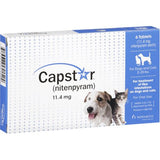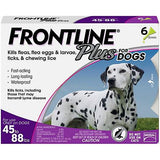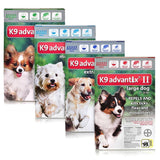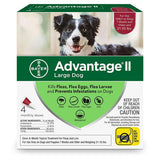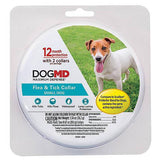News
The Best Flea and Tick Prevention and Treatment for Dogs

WHY IS FLEA AND TICK CONTROL IMPORTANT?

Fleas and ticks are tiny external ectoparasites that feed on the blood of warm hosts. Unfortunately, a dog’s soft, warm fur provides the perfect environment for fleas and ticks to thrive. Despite their small size, fleas and ticks can cause monumental problems, including health complications that range from allergic reactions to life-threatening tick-borne illnesses. Both of these parasites have strong, resilient life-cycles and are prevalent across every part of the country: female fleas can lay 40-50 eggs a day, and ticks can lay dormant for an entire year without feeding.
There are endless opportunities for fleas or ticks to climb aboard your dog, even during short walks around the neighborhood, play dates at the dog park, or visits to the local groomer. Dogs that spend the majority of their time indoors are at equal risk of infestation as outdoor dogs since fleas and ticks easily travel from host to host. If not prevented or treated, these parasites can cause many health problems for dogs, including:
- Skin inflammation, rashes, and infection
- Scabs and scales
- Anemia
- Transmission of disease (i.e. Lyme Disease, Rocky Mountain Spotted Fever, anaplasmosis, ehrlichiosis, etc.)
- Severe psychological distress from constant itchiness and scratching
Because your dog provides both a comfortable home and a continual food source for these pests, fleas, and ticks will remain attached to your dog until steps are taken to eradicate them. It’s critical to not only treat flea and tick infestation on your dog immediately but also to take preventative measures in protecting your dog from the harmful effects of fleas and ticks. Flea and tick infestation can easily be prevented with the right products.
WHAT ARE THE BEST FLEA & TICK CONTROL PRODUCTS FOR MY DOG?
Determining the most effective line of defense to protect against fleas and ticks is not a “one size fits all” process – there are several factors that must be considered when choosing the right preventatives, including your dog’s age, weight, lifestyle, medications and health concerns. Parasitic prevention and treatment products are generally administered either orally (in pill form) or topically (by applying the preventative directly to your dog’s skin). Some flea control products kill adult fleas, while others target flea eggs and larvae by preventing them from hatching.
It’s important to act quickly when your dog has fleas in order to prevent a full-blown infestation that can wreak havoc on your dog and your home. Although infestations in dogs are notoriously challenging to treat, Pets Go Here features an extensive selection of flea and tick products that are highly effective in stopping – and preventing – parasitic infestations. The following industry-leading insecticide products provide powerful yet safe protection and treatment against parasitic infestations in your pup.
Oral Treatments
Flea and tick control medications – available in chewable or pill forms – are ingested instead of topically applied to your dog. They can offer a mess-free, convenient alternative to topical treatments, particularly for dogs with sensitive skin.
- Capstar is regarded as one of the best flea pills for dogs on the market. Its active ingredient is nitenpyram, a synthetic insecticide that absorbs into the bloodstream quickly, killing over 90% of fleas within 4 hours. It is also capable of killing ticks. Capstar will only kill adult fleas that have already fed on your dog, and nearly 100% of the nitenpyram is eliminated from your dog’s system within 24 hours. Because of this, Capstar works best for providing immediate relief instead of long-term prevention. Side effects, though not unknown, are rare.
- With the same fast-acting active ingredient as Capstar, Dog MD Quicktabs tablets provide safe, quick relief for flea and tick-infested dogs, beginning to work within only 30 minutes. A single dose should eliminate all adult parasites from your dog, but if re-infestation occurs, another dose can safely be given as often as once per day. This along with some basic blue Dawn dish soap will give you a good start to getting rid of the fleas in your home.
Topical Treatments
Owners whose dogs have an aversion to or difficulty with ingesting pills will find topical treatments far more practical and user-friendly. Topical treatments, also called “spot-on” treatments, are typically liquids that are applied to your dog’s coat (generally between the shoulder blades so that your dog is unable to lick it off).
Most Topical flea and tick treatment for your dog last for a one month period of time. A three, six or twelve-month supply are the most popular. If a big sale is happening, stock up! There is no expiration date and a lot number is always imprinted into the EPA approved box. The lot number may be looked upon by the manufacturer's website for further information. Seresto Collars are a good alternative to topical treatments. The Flea and Tick repellent collar last up to 8 months for continuous protection.
- Frontline Plus is a leading monthly topical flea preventative capable of killing up to 100% of adult fleas on dogs within 12 hours, preventing the next generation of flea eggs and larvae from ever hatching. This scent-free, clear liquid flea medicine is applied to your dog’s coat.
- Veterinarian-recommended K9 Advantix II kills fleas, ticks, mosquitos, and lice on contact, meaning these parasites never need to bite before the treatment becomes effective. Only one application of this waterproof topical preventative offers 30 days of protection from parasites, destroying all flea life stages and repelling biting flies.
- Advantage II provides monthly topical flea prevention for dogs and kills fleas within 12 hours of application. This odorless, waterproof treatment works to break the flea life cycle, killing flea larvae, flea eggs and chewing lice on contact. Notably, this product will never expire if stored according to its package specifications. Advantage II is suitable for puppies and dogs 7 weeks of age and older.
Flea & Tick Collars
There are several safe and effective alternatives to oral and topical treatments available that can both treat and prevent parasite infestation in your dog, most notably flea & tick collars. Flea & tick collars work by continuously releasing insect repellent chemicals that gradually spread across your dog’s body through the natural oils of the coat and skin. By adhering to your dog’s hair and skin, these repellent chemicals can provide long-lasting, continual protection.
- Seresto is an odorless, non-greasy dog collar that provides safe and effective protection from fleas and ticks for up to 8 months. Manufactured by Bayer and highly regarded as one of the most effective dog collars on the market, Seresto is designed to slowly and continuously release its active ingredients (imidacloprid and flumethrin), repelling and killing both fleas and ticks on contact before they bite. Fleas are killed within 24 hours of initial application, re-infesting fleas are killed within 2 hours, and tick infestations are prevented within 48 hours of application. This water-resistant collar remains active after bathing, swimming, and exposure to rain or sunlight. However, the control duration is reduced in dogs that are bathed or swim more than once a month (reduced to 5 months for flea control and 7 months for tick control).
- Dog MD Maximum Defense Flea and Tick Collar is a long-lasting, waterproof collar. Its active ingredient (deltamethrin) provides up to 12 months of protection against flea and tick infestation. This product is not suitable for puppies under the age of 12 weeks old.
Proper Usage of Flea & Tick Control Products
Nearly all flea and tick preventative products offer variations of their formulas to correspond with your dog’s age and weight. However, according to the American Veterinary Medical Association, young puppies and senior dogs are not suitable for many flea and tick treatments. Likewise, certain breeds are particularly sensitive to ingredients found in some flea and tick treatments.
Certain unrelated medications that your dog takes can interfere with some ingredients in flea and tick medications. Be sure to talk to your veterinarian about the best options for your dog’s flea and tick treatment and prevention. Never use flea and tick control products intended for dogs on cats. Although there are just as many flea and tick control products available for cats, certain ingredients found in treatments for dogs may be highly toxic to cats. Always follow all label instructions on flea and tick control products carefully to ensure maximum effectiveness.
WHAT OTHER FLEA & TICK CONTROL STEPS CAN I TAKE TO PROTECT MY DOG?

There are several proactive steps that you can take to help reduce the likelihood that your dog will fall victim to flea and tick-related problems. Although ticks can be found anywhere, they are prevalent in heavily wooded areas, tall grass, and moist environments. Removing leaf litter from around your house, regularly mowing your lawn, and keeping your bushes trimmed back are all effective ways to reduce the number of ticks around your home. Avoid leaving bowls of pet food or water outside, since this encourages feral animals (particularly flea-carrying possums, raccoons, and stray cats) from coming into your yard and bringing their fleas with them.
Since fleas are often found a dwelling in carpeting and throw rugs, vacuum your home at least once a week, and more often if fleas are spotted. According to the AgriLife Extension Service of Texas A&M University, regularly cleaning your baseboards, cushions, and anywhere your dog sleeps or spends time can eliminate 30% of flea larvae and 60% of flea eggs.
Whenever your dog spends time in wooded or grassy areas where ticks love to lurk, make a habit of performing a ‘tick check’ on your dog’s coat.

If you ever discover a tick, spread your dog’s fur then grasp the tick with a pair of fine-point tweezers as close to the skin as possible. Pull straight upwards in a steady, slow motion to avoid tearing the tick and spreading potential infections into the bite area. Do not squeeze or crush the tick, as its fluids may contain infectious material.
After you’ve removed the tick from your dog, examine it to ensure that the head was removed as well – if not, you and your pup will need to visit the vet to remove what’s left. If the entire tick is removed intact, kill it by placing it in a container with rubbing alcohol and disinfect the bite area with an antiseptic spray or wipe. Keep a close eye on the bite area over the next couple of days – if there are persistent signs of redness, inflammation or infection, make an appointment with your vet immediately.
Ultimately, base your decision on what you are needing to protect against and also repel against. Seresto Collars are easy while a monthly topical requires pet owners to remember to apply the medication monthly. With proper preventative steps and products, you can ensure that your beloved pup never becomes an unwilling host for harmful, pesky parasites. One of the most convenient solutions to preventing flea and tick infestations would be to set up an automatic, recurring delivery today at Pets Go Here!


